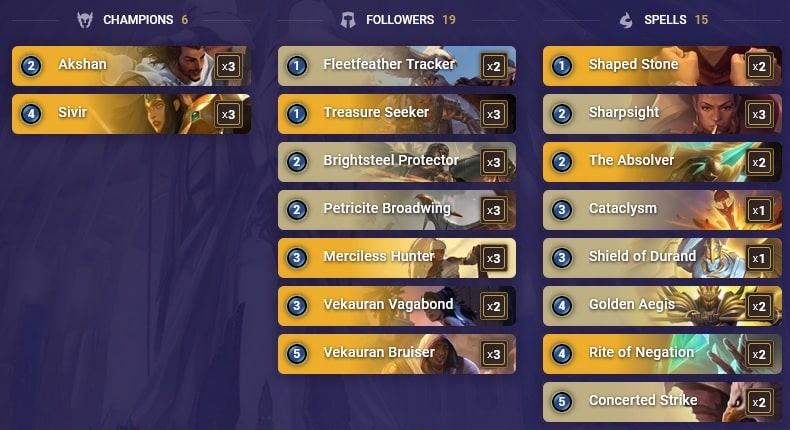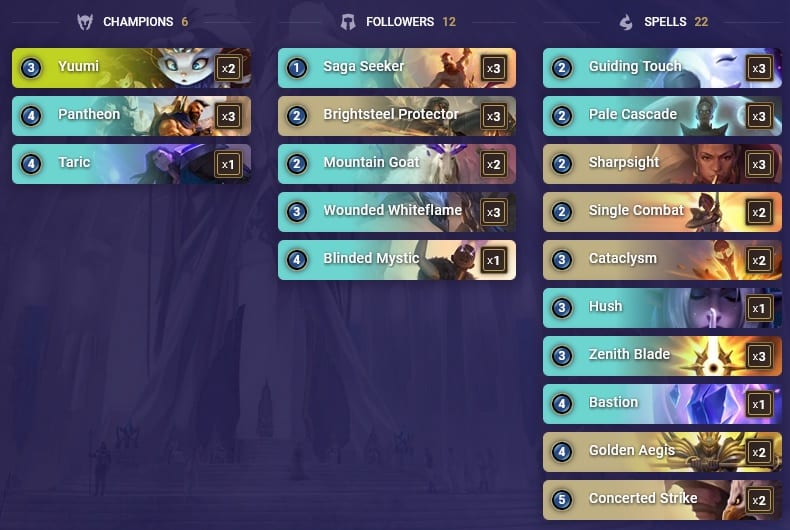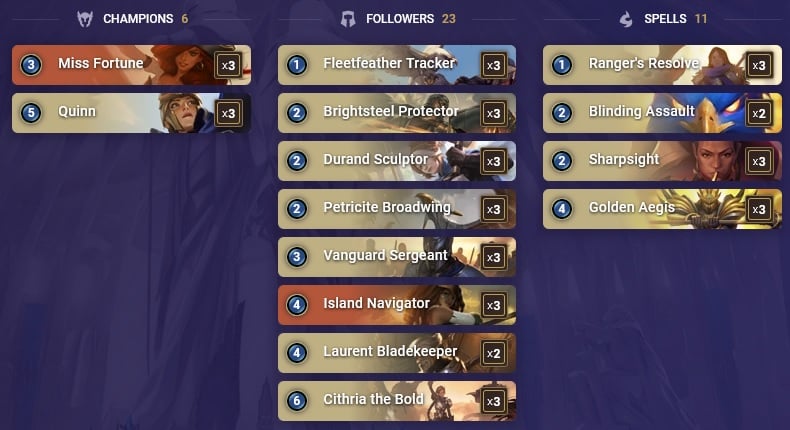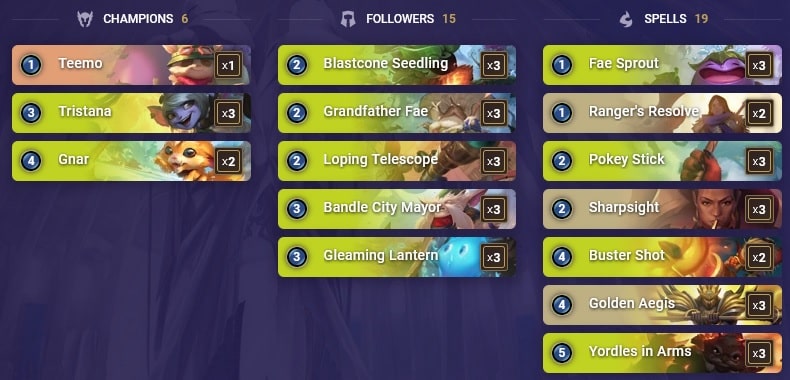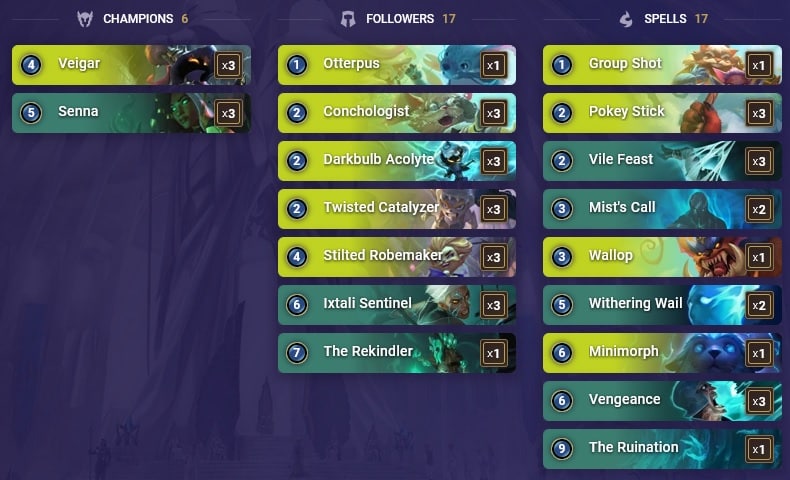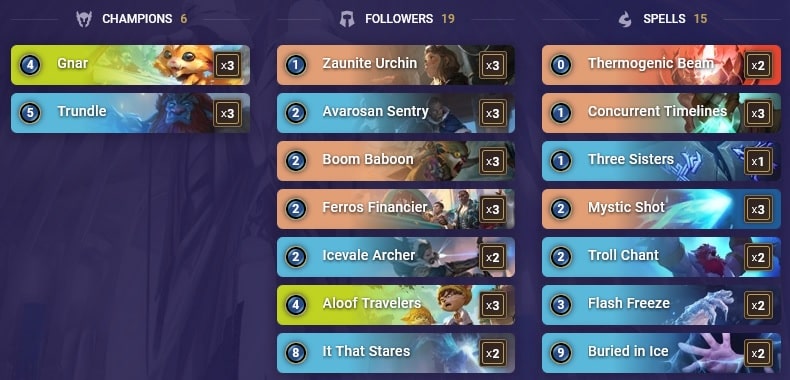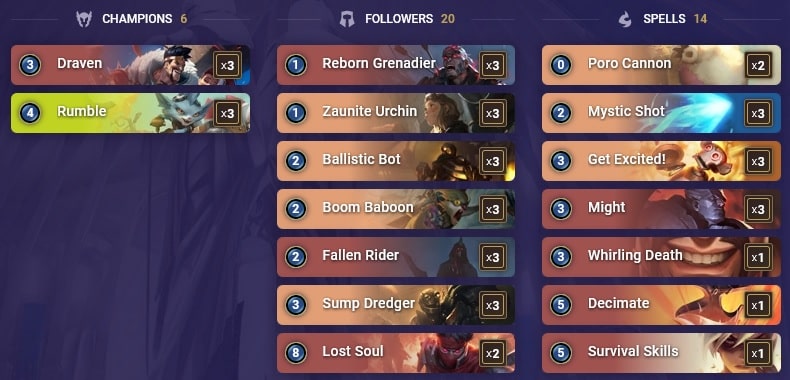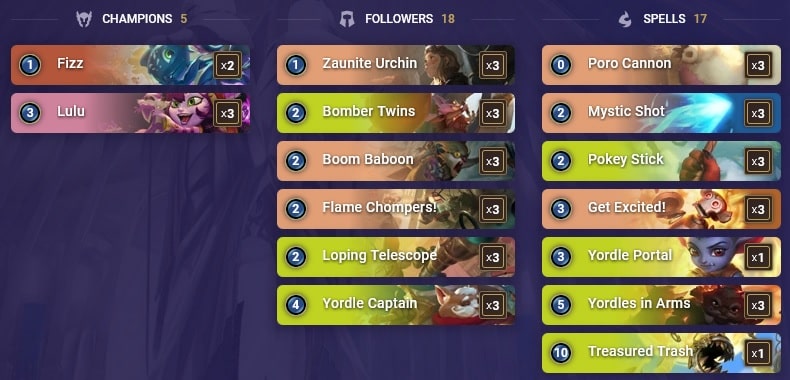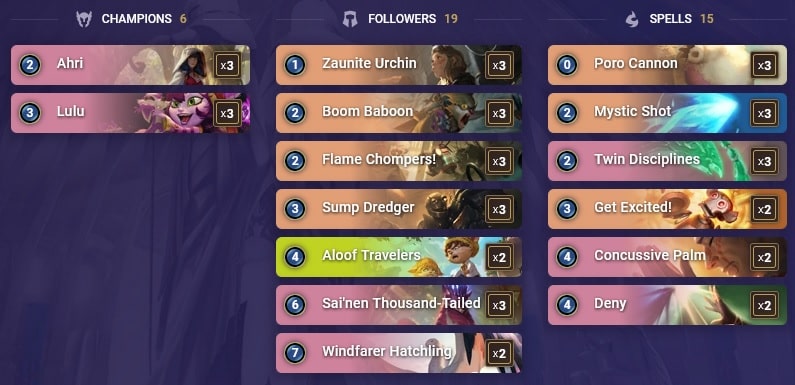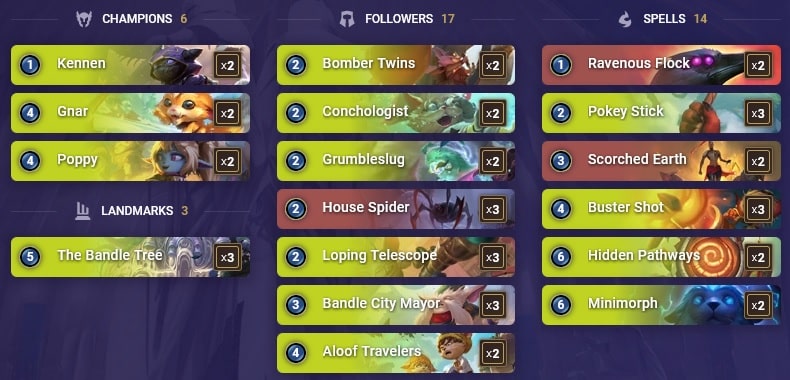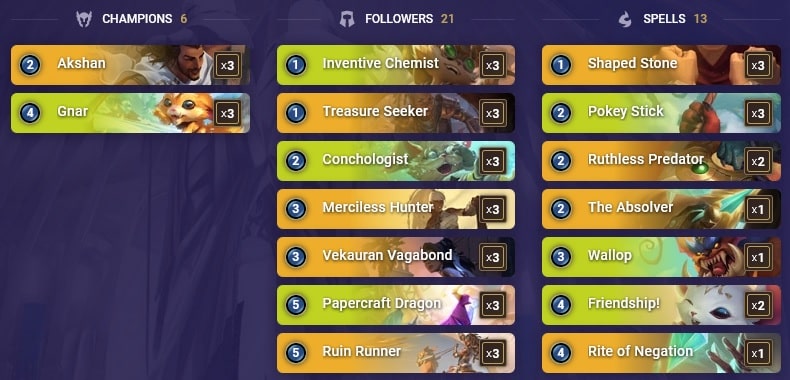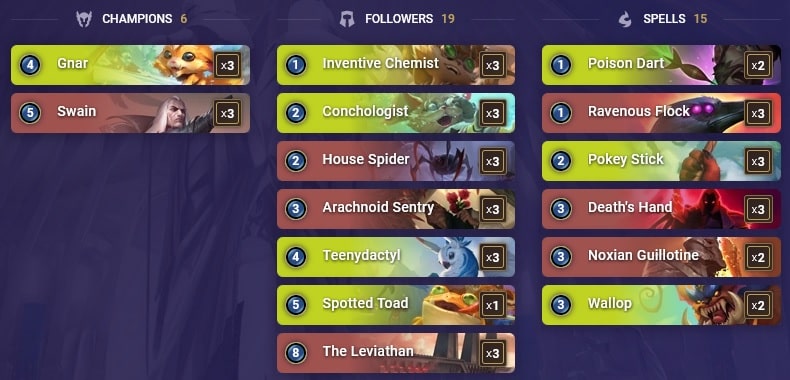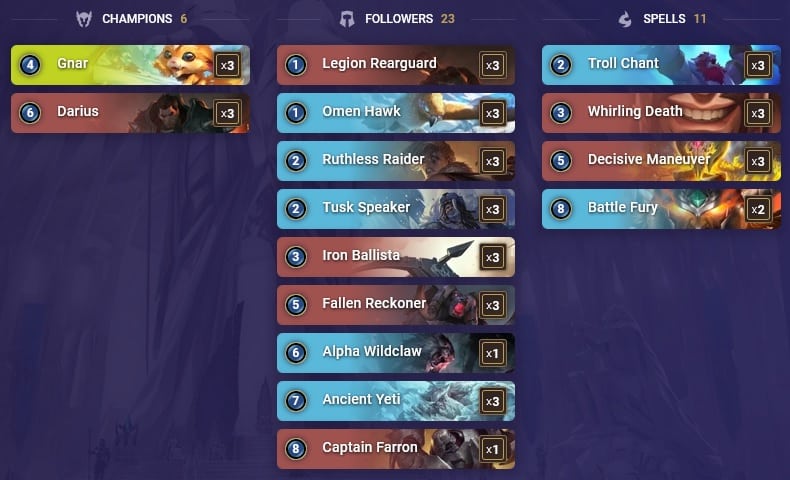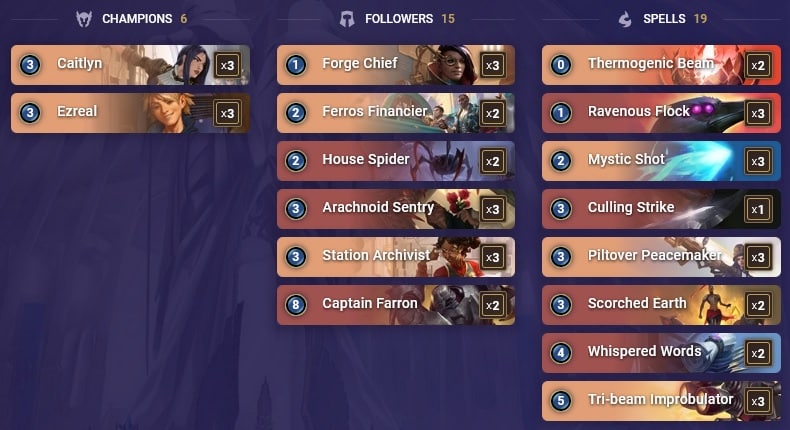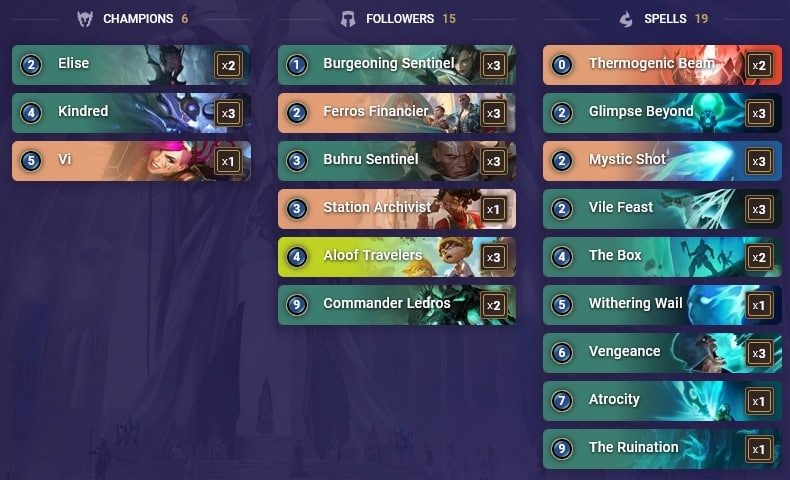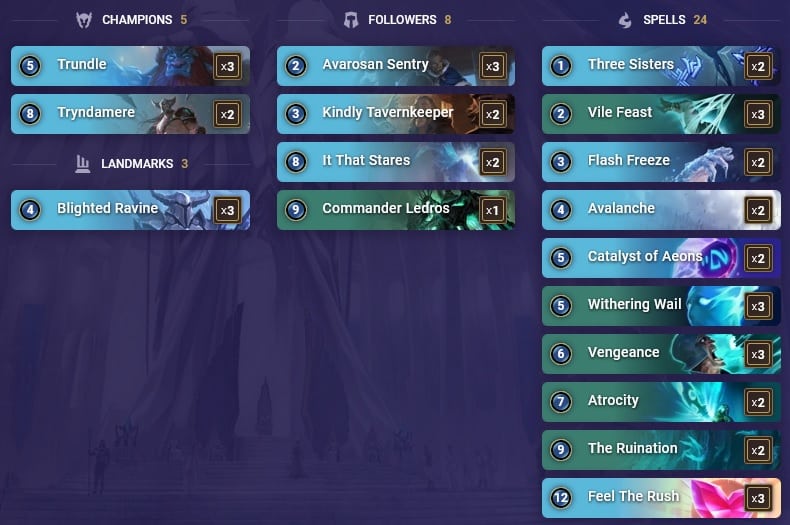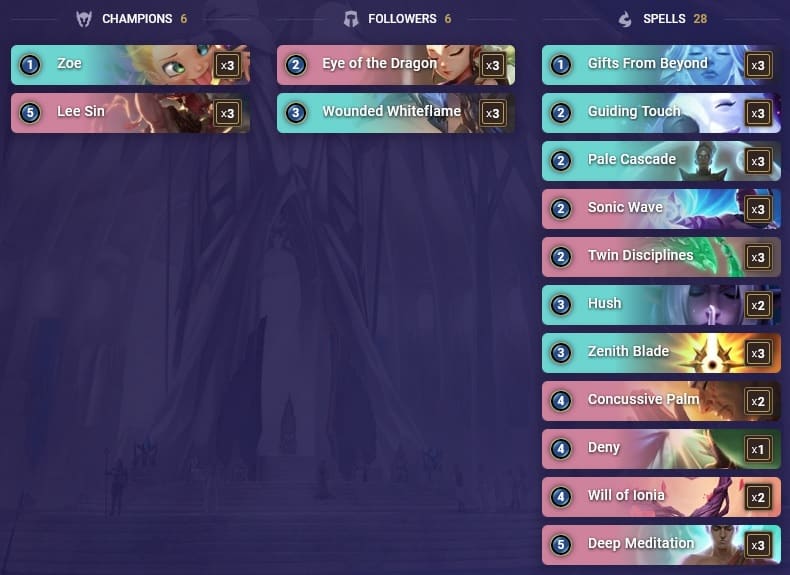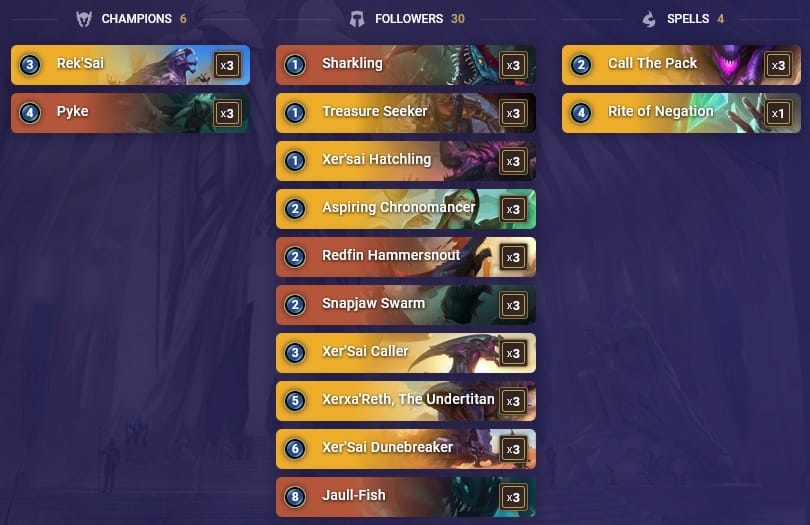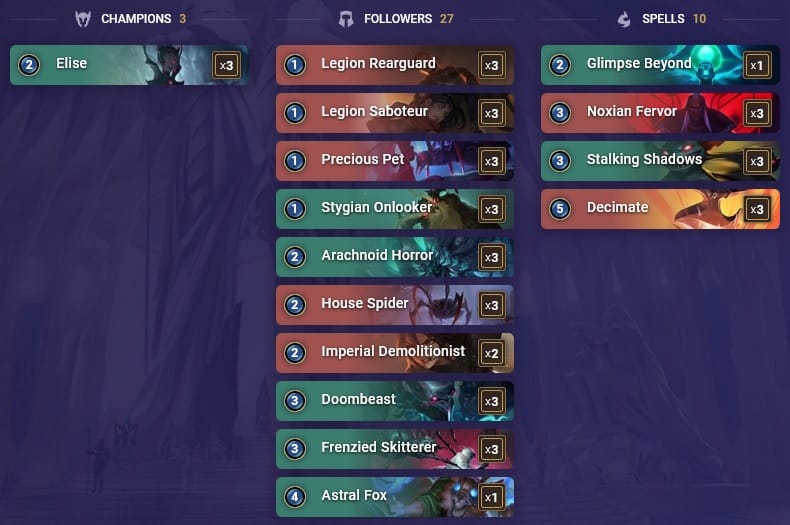Welcome to TLG’s latest meta snapshot for Legends of Runeterra, a series in which we give you our insight on the finest decks in the higher ranks of the ladder. As the developers have set out their stall for fewer competitive updates over the coming year, we’re planning to do occasional snapshots to cover the bigger changes.
If you have any questions, feel free to drop by our Discord. Best of luck on your climb!
Graphics: WellMax81
Editing: Wusubi, Sebodunum
Writers: Den, Ultraman, Othal

CMCACAIABEAQGAAOAECQADAFAQDRINTHQEAYEAIEAEAQAHIBAIAACAIEAABAIBAHHNOYAAMKAEBACBAAAMAQKAAU
Difficulty: Hard
It’s been a while since Akshan-Sivir dominated the ladder, but Demacia is back in full force, profiting from a Midrange-oriented environment, where Aggro decks are barely playable. With many First Strike effects on both of your champions and a good use of the Challenger and Vulnerable keywords, the deck is extremely proficient at trading.
I know, I know, it’s Demacia, but this deck is especially strong at value trading, using the likes of Cataclysm, Single Combat and Concerted Strike to dominate the board. Similarly to Pantheon, this list is one of the best options to beat faster Demacian decks that need to set-up their board before they can threaten the Nexus - they struggle to do that in the face of your majestic units.
Akshan-Sivir is also favored against control decks, as SpellShield can change the course of the game. (Write-up by Ultraman)
CQCACAIABEAQGAAOAMBQSGZDGMBQKCIDAUDAKAIBAANACAQAAEAQGCK4AECQUHICAQAAEAYCAECQSCQDAMERGOSV
Difficulty: Moderate
We debated merging the Akshan-Sivir and Pantheon write-ups given their similarity in terms of matchups, but the gameplay itself is slightly different. Pantheon is just as good against faster Demacian decks and control decks, while sharing the same weaknesses against Aggro.
Instead of using First Strike and relying on value trades, the deck uses the Fated mechanic. Your followers are too big to die. Yuumi helps with turning your units into an invincible wall of stats, and if that isn’t enough, you also have multiple buffs and heals at your disposal (Guiding Touch, Pale Cascade, Sharpsight).
This might sound strange, but having a bunch of stats is the only strength of the deck. In order to beat it, you have to focus on direct damage, swarm or kill mechanics. If you dare to challenge a Pantheon player to a game of stats, your only hope is that they miss out on a key card. (Write-up by Ultraman)
CIDACAYABYAQIAACAIBAMFR6AIBAABQHAICQACQMAQAQABQJDUZQEAIBAABQCAQAAIAA
Difficulty: Easy
Scouts is a fast-paced Midrange deck and as usual, the goal is to overwhelm your opponent using the Rally mechanic. The fact that every Demacian deck uses Rally would suggest that the ability to attack twice per turn might be overpowered, but anyway, this list is the best at Rallying, especially during the opponent’s turn.
Each turn, if you attack only with Scout units, you gain a renewed attack token, helping you deal massive damage each time the opponent gets overwhelmed. Miss Fortune and Quinn are perfect in this deck, as they both require you to attack 4 times before flipping into amazing fountains of damage and value trades.
The good news for Scouts is that they can develop a secondary win condition due to wonderful units like Durand Sculptor and Petricite Broadwing. Your units can survive anything, allowing them to benefit from For Demacia! and Cithria the Bold’s buffs. You can just outswarm the opponent and finish off their Nexus while they focus on your champions. (Write-up by Ultraman)
CQBQCAYABYAQIAACBECQUIDPOB2IKANGAGXQDNYB3EAQEAICAADQEBIKQQA2CAIBAEAQICA
Difficulty: Easy
You don’t want to mess with Tristana, Gnar and their Faes. It’s debatable for now, but this deck might be more efficient at using Yordles in Arms than Fizz-Lulu. You’re able to fill the board extremely fast, activate Yordles in Arms simultaneously and maybe even Rally afterwards.
The usual Demacian tools are at your disposal, and are best used to protect Gleaming Lantern or Grandfather Fae. With a lot of card creation, the deck doesn’t want to empty its hand too quickly. If you manage to find the right cards in your opening hand, you should be able to fill the board two or three times.
Let’s talk about Hungry Owlcat, shall we? SpellShield is a ridiculous keyword to have on a 1-mana unit. Your opponent will face tons of 4-attack Owls that cannot be removed. And yes, they’re the perfect recipients of the buffs from Yordle in Arms.
Gnar helps with prolonging the opponent’s suffering, with the extra draw of Pokey Stick that might end up drawing more card generation such as Loping Telescope, which might create another win condition and steal the game. (Write-up by Ultraman)
CQBQEAIFAEUAEBIFBAEQMBIKGE4V2XTCUYAQCAQBAUOS4AQCAECQ6FAEAUFACBGGAHKQC
Difficulty: Hard
Veigar-Senna requires a bit of skill to pilot, as you have to set-up your main win condition: making Darkness as big as possible. And since Twisted Catalyzer and Veigar are the only cards that can actually do it, you’ll need to master another important skill; being lucky enough to draw them.
It’s simple - if you manage to find both cards before Turn 4, you can win every game, but if they decide to have a picnic at the bottom of your deck, you’re probably going to lose. That said, make clever use of thinning and mulligans to increase your odds, and try your best to stall for time until you find what’s needed.
Once your Darkness is big, make sure you reduce its cost and then it’s time to spam. You can create Darkness multiple times per turn with Senna and double-dip on its damage with Ixtali Sentinel in order to level-up Veigar. Don’t forget to utilize your removals and healing to actually stay alive while scaling. (Write-up Ultraman)

CQDACAIBAMAQGAIGAECQIGACAECC2NACAQCAUEACAUFJQANBAECACAIEDMAQIAIMAIAQCAILAIBQCAQDAEAQIAIK
Difficulty: Moderate
If only life was as simple as this deck’s game plan, which is to play Concurrent Timelines. This is one of the lists that no one saw coming, but cards like Ferros Financier and Buried in Ice actually made it happen.
We have to mention Gnar, as the lack of a second champion was a huge problem. While Gnar doesn’t really offer any synergies, the deck itself is a pile of value cards to begin with. You have a few combos such as Buried in Ice into It That Stares or Timelines into Ice Pillar, but that’s about it.
Troll Chant is still Freljord’s best card and Aloof Travelers have a couple of decent targets while benefiting from Timelines, given their weak stats. (Write-up by Ultraman)
CQDACAYEAUAQIBAQAECQUWACAEBRGFACAUBQMDIEAECCMJZNGQBACAYECIAQKAYJAIAQGAYPAIAQGAQL
Difficulty: Easy
Draven-Rumble is one of the few Discard variations that still sees some play after the nerf to Sion. With a low curve and a lot of direct damage, it fits the bill of an Aggro deck, but Lost Soul straightens your curve and allows you to take a slower approach.
That said, the deck is prone to having poor opening hands and is a bit unreliable. Rumble can high-roll every now and then, but most decks have enough answers these days, which makes it hard for Rumble to become an actual carry. Your plan B is finding some direct damage through Elusives and Ballistic Bot and hope that your Burn will be enough to steal the game.
The instability of the deck is compensated by its favored matchups against Fae Swarm and The Bandle Tree, and by how strong the perfect hand can be, with Reborn Grenadier being so dominant in the early game and Survival Skills giving you a free trade.
Might is a specific win condition, mainly used on a Ballistic Bot or a Rumble with SpellShield - add an extra Whirling Death to the mix and you can deal a lot of damage. (Write-up by Ultraman)
CQCQCAYCAIAQGBASAECAIEAEAECAYJZNGQCQKCTPPCTADLYBYAAQCAICAYXACAQFBI2MQAI
Difficulty: Easy
Lulu is followed by her Flame Chompers! friends, helping her make value trades in the early game. As a win condition though, this is on the weaker side. The archetype never really took off until the inclusion of Yordles in Arms, benefiting from the swarm based nature of the deck.
This allows you to create a board full of gigantic units and use them to either force trades or simply finish off the game due to absolute board domination. The deck is pretty good against Demacia, but it struggles if your followers get removed each turn. Yordle Captain is your best tool to prevent that from happening, as raising the health of your units by 1 is often enough to save most of them from cheap removal.
But alas, if that isn’t enough, your last call is the 10-mana Treasured Trash. Embrace the true nature of Bandle City and let RNG decide your fate! (Write-up by Ultraman)
CQDACAICBQAQGAQCAEBQIEQBAQCBAAQFAICAOBABAQGCMLJUAQAQCBBHAEBAEBIBAUFJQAICAEBBKMIA
Difficulty: Hard
Ahri still exists, but only in the form of another Lulu & Flame Chompers! combination. You can buff Ahri and watch her switch with Chompers, effectively trading with an opposing follower while giving you a new Discard target.
Outside of that fun little interaction, the deck excels at keeping its cards alive, due to both Deny and Twin Disciplines. You can wear out the opponent with Elusives, leading into a Sai’nen Thousand-Tailed or Windfarer Hatchling finisher.
Aloof Travelers are a necessary inclusion to help you stabilize in the mid game, as the list needs to slow down between turns 3 and 6 in order to keep a full hand and react to the opponent’s plays. The current version of the deck is quite stable, but it’s not an easy task to pressure your opponent while keeping a full hand and staying alive. (Write-up by Ultraman)
CQBACAIDG4CQKCTUQQA2MANPAHBACAYBAIBQSAIDAMGQSBIKAENCSMJ2NKMADIIBYAAQA
Difficulty: Easy
Are you sad when playing a card means having one less card for the next turn? Don’t worry, The Bandle Tree is here. Even if the deck combines two of the most pokey regions in the game, it offers a variety of ways to win the game - especially once you start generating new cards with Loping Telescope, Bandle City Mayor and of course Bandle Tree itself.
You have a lot of disposable creatures to protect your Nexus and to damage some key opposing units for a Scorched Earth or a Ravenous Flock while progressing your win condition. Even so, as an aggressive deck, Bandle Tree is outshined by Demacia and some Gnar decks.
Poppy is a great swarming threat, and if she sticks to the board, she’ll keep buffing your units to a point where it’ll be impossible to survive the pressure. This might win you some games, but it’s not where the deck truly shines. The real power of Bandle Tree shows itself against slow control decks like Darkness.
Yes, you’ll put weak creatures on the board and they’ll die to the simplest removal, but that’s not an issue. You have many ways of generating new cards, allowing you to keep the pressure up and stay alive until Bandle Tree hits the board.
Then it becomes a race against time for your opponent, who simply knows they need to kill you in a few turns. And that’s the biggest strength of the deck: when the Tree is on, you only need to think about how to survive, while the opponent needs to think about how to win. (Write-up by Othal)
Akshan-Gnar
CEBAKBIKGFE2CANGAGYQCBQEA43DOXLHQAAYEAICAECAORIBAUFK4AICAECQVVIBAICAOO4KAE
Ziggs-Gnar
CEBQEAQDAMCAIAIDAIGCQNYHAUFAODRRJGQQDIYBUYAQAAIBAEBQ6
Gnar-Swain
CEBQEAIDFY3QIAQDAEDQQCIFAUFA4MKJUEA2MAICAEAQGFQCAUFKIAOVAEAQCBIKVAAQ
Gnar-Darius
CEEACAQBAYAQGAICAECQCBQBAIBQKAIFBKQQCAIFAMHQEAIBCYPQIAIDBMGA2JQBAEAQCBICAEAQCGQBAEBTG
Gnar is the most popular champion right now. The Yordle is reminiscent of Poppy’s domination back in the second half of 2021, where she was a huge tempo enforcer and slotted in basically any deck using the Bandle City and Demacia regions. Gnar feels very similar in the way he’s currently played.
He can serve as a removal, a value engine or simply another threat on the board for your opponent to deal with. Thanks to this combination of power and flexibility, Gnar appears in many decks, and they’re all decent in the current meta. We chose to give them one big category in our snapshot, as they feel similar in terms of power level. On a side note, Wallop is a great champion spell that’s being used in most of those decks and sees play even in decks that don’t feature Gnar (e.g. Darkness).
Most Gnar decks are tempo-based, with minor twists in how they operate. The pairing with Ziggs or Darius is damage-based, either through the Burn mechanic or the Overwhelm keyword. Both decks aim to put their opponent on the back foot in the early game, allowing them to press the advantage and set-up their bigger damage enabler. Gnar can help with sustain due to Pokey Stick generation, but the real shining moment is the level-up, turning him into a massive Overwhelm unit.
Akshan-Gnar and Gnar-Swain are more board-based decks, although different in their approach. Akshan is a proactive deck, while the Swain version is capable of adopting a reactive playstyle. In those decks, Gnar’s Pokey Stick is a solid help, as you’re looking to play longer games than with the Noxus pairings. When flipped though, he can still push a lot of damage if needed.
Overall, each Gnar deck is worthy of Tier 2 contention, with ups and downs depending on the meta at your rank. But one thing is for certain, he’s a powerful champion that can fulfill various roles in order to adapt to different matchups. (Write-up by den)
CECQCAIDFYAQEAYJAEBQIEICAECCINAEAUCAMDANDECQCAIEDMAQGAYNAECAGAQBAUCBQAQBAMZTOAIBAEBQI
Difficulty: Moderate
Tri-beam Improbulator is back in the meta. It’s been a few months without the lovely Ezreal-Draven, sorry, Ezreal-Caitlyn deck. Packing a lot of cheap removals, the goal is to stop the opponent from developing a board while building a huge Improbulator in order to have enough tempo to win the game.
The game plan has changed a bit, given the deck doesn’t have the ability to play the value game anymore, especially against the likes of Bandle City and their Manifest keyword. After some changes, the deck is now more proactive and tries to pressure the opponent at every stage of the game. It has decent early game units, Improbulator for the mid game and Captain Farron combined with a leveled-up Ezreal to seal the deal.
Always good against other Midrange decks, relatively fine against Aggro and bad against control, the list still feels the same despite the changes to its game plan. If you’re yearning for a trip down the memory lane, look no further than Ezreal-Caitlyn. (Write-up by Ultraman)
CQDACAIEGQAQIBIFAECQVGABAECQIGACAUCQWDYDAECQCKBRAIAQCBA3AMAQKEZBGUBQCAQEBAAQKBAMAMAQKDYZDU
Difficulty: Easy
SI/Piltover has always been a popular combination, and has been performing more steadily as of late. The deck used to struggle against Demacia, but has been doing better since Kindred’s buff to 4-mana and Vengeance’s buff to 6-mana.
The Sentinels add an extra layer of pressure against otherwise bad matchups, like The Bandle Tree that often struggles to clear the Fearsome units. Given their decent amount of health, they help against Demacia and other control decks.
You obviously have an amazing matchup against Aggro decks thanks to Vile Feast and many cheap removals. The Ruination is especially important in this Demacia-heavy meta, and is needed to overcome some of the stronger Demacian boards. Atrocity and Commander Ledros make for a nice combo, allowing you to finish off the game. (Write-up by Ultraman)
CECACAIBAMAQIAIOAIBQCBQWAMAQKAI5FACACAYBAMAQIAIKAIAQKDYZAUAQCAIMCQTTEAIBAECSC
Difficulty: Moderate
With long games and an easy game plan, Feel The Rush is the entry-level control deck and an old-time classic that I’m sure you’ll thoroughly enjoy. As long as you avoid Pantheon and Scouts. Oh and Darkness. And also The Bandle Tree. Okay, you’ve got to avoid quite a few decks, but none of those matchups are strictly unwinnable.
Why is this deck in Tier 2 with so many bad matchups? Well, that’s because it has just as many good ones! Enjoy crushing the poor Faes, and laugh as the swarm decks get reminded that Freljord has control tools, and great ones at that. Avalanche and Blighted Ravine will crush their body, mind and soul.
Noxus/PnZ decks are easy to beat for similar reasons. You’ll be able to play the reactive game against those, maximizing the value of your removals before healing yourself to avoid any unpleasant surprises. (Write-up by Ultraman)

CICACAICBQAQKCIGAQBAEAYGBAEQKAYJBENSGM6XAEBQCAICAIAQEAQFAEBQSVIBAEAQEMI
Difficulty: Hard
You thought Lee Sin was going away? Think again! While most decks benefited from the latest expansion, Zoe-Lee relies on its power level and a strong finisher to try and compete with the new flavors of the month. It remains strong against Aggro due to Eye of the Dragon and Wounded Whiteflame, but the leaders of the meta have numerous ways of dealing with it, making it a difficult choice for climbing the ladder.
Bandle City decks are quite efficient at turning your main threat into a wow-reacting mammal thanks to Minimorph, and they can play around Bastion due to their high number of low-cost spells. As such, we aren’t including the SpellShield-giver in favor of cards that help with our win condition.
Against Demacia, board swarm and Rally are the issue. Lee’s best protection are the Dragonlings, but since they’re Ephemeral, they can survive for one combat each round. The presence of Concerted Strike means Demacia can play around your Barrier.
Pantheon is a huge problem, coming online faster than Lee Sin, with likely bigger stats and no conditional keyword activation. His decks also include a Silence package with Blinded Mystic and Hush, effectively turning your Eye of the Dragon into food for their own Wounded Whiteflame.
When not facing the difficult matchups, the game plan remains the same: Eye of the Dragon and Gifts from Beyond are here to provide the best answers against Aggro and swarm decks without Rally, so try and put them down as fast as you can. Your goal is to survive until you can close the game in one swoop with a Zenith Blade-buffed Lee Sin.
At times, you might want to threaten the opponent without Lee Sin and force them to answer a boosted Wounded Whiteflame. Even though the card won’t win you the game, every removal used on a different target than Lee Sin is great for you.
In the end, Lee Sin remains one of the most difficult decks, but also one of the most rewarding. Every game is a puzzle you need to solve, and even while losing, you’ll be a better player for it. (Write-up by Othal)
CMBAKBAGAEBQKBYPBACAOAITCY3ECRCKKAAACAIEA45Q
Difficulty: Easy
Lurk struggles a lot in this meta. While the deck is a classic and a hard one to count out, the matchup against Demacia is even at this point. As such, Lurk’s matchup sheet suddenly doesn’t look appealing. Most decks have an early game presence, making it difficult for you to deal damage, and your late game units with Overwhelm get shut down on a regular basis.
Pyke’s spell is as good as before, but Rek’Sai has a hard time leveling-up in the current environment. The deck might be decent in tournaments, but we don’t recommend playing it on ladder. (Write-up by Ultraman)
CECACAQDAMBQCBJHGU4AGAYFAMCAMBIBAMBAYDZIG4AQCAQDAQBACAIFGEAQIBIM
Difficulty: Easy
Elise is one of the best anti-Pantheon decks out there, and it’s just as good against Akshan-Sivir. But if that’s the case, why is it only rated 3 stars? Well, that’s because both Scouts and Darkness shut it down extremely hard. All the control decks are natural counters, and the Midrange decks don’t fear the Fearsome keyword as much as they used to.
You can try using Frenzied Skitterer to surprise your opponent, but your linear game plan requires the opponent to misplay or miss their key cards. That said, you have tons of direct Nexus damage, which can always steal a game. The deck is best used as an anti-meta pick, or in tournaments to target slower Demacian decks. (Write-up by Ultraman)


